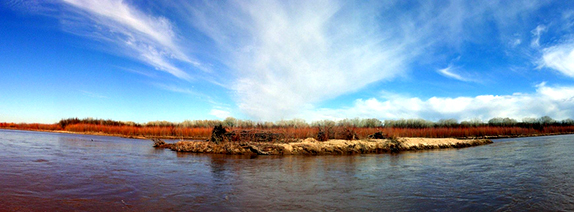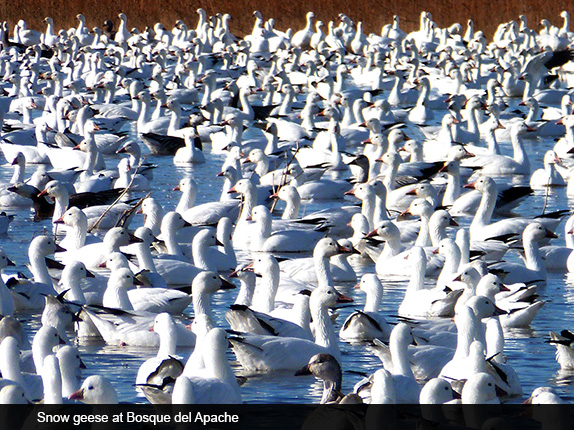
We stand outside the handsome visitors center, an atoll in the midst of a vast brown sea. The sea is the Sevilleta National Wildlife Refuge, 230,000 acres of Chihuahua Desert, Colorado Plateau, high plains grasslands and two mountain ranges, the Ladrón and Los Pinos.
There are few people in this 30-mile by 15-mile slab of New Mexico between Belen and Socorro: a scattering of ranchers in enclaves along the Rio Grande, a few biologists and geologists, five rangers, a handful of volunteers living on the reserve for three months at a time—and we, of course, a photographer and a reporter who have come to discover the story of this unique place.
Occasionally the public is allowed onto this land, typically once a month when tours for the lucky few are conducted by reservation. Otherwise sightseers are barred from the refuge, which is devoted to conserving and investigating the land, plants and animals of New Mexico.
Forty years ago this month, the Campbell family donated Sevilleta to the government as part of the largest private land donation to the U.S. government in history. The family is the same one that has been trying for years to develop Campbell Ranch in Edgewood into what amounts to a new city of about 10,000 people. It is the same family who, in partnership with the Rockefeller family, invented the whole idea of industrial agriculture, which is what today feeds America along with much of the rest of the planet.
Next to the visitors center is a scientific center. Here are based biologists from UNM who investigate everything from the temperature adaptation of lizards, to the survival conditions of Rocky Mountain Big Horn Sheep, to how Mexican gray wolves can be restored to the wild, to the effects of global warming on the Southwest.
Meanwhile geologists from New Mexico Tech in Socorro study the refuge’s 1.66-billion-year-old rocks and try to understand what is happening to the Rio Grande Rift. The rift is growing a millimeter a year, which doesn’t sound like much but is enough to have created a basin 18 miles wide in a mere 30 million years. Hundreds of small, deep quakes regularly shake the basin. Renee Robichaud, deputy refuge manager, says she has felt the quakes shake the shelves in the visitors center.
In time for its 40th birthday, the refuge has just completed installation of a raft of new exhibits, many of them interactive. They illustrate the four biomes, or large ecosystems, that come together in the refuge. From arid desert to piñon and juniper mountain slopes (the highest point hereabouts is Ladron Peak at 8,900 feet, which is actually on BLM land just outside the refuge), the intersection of so many different kinds of environment make this a uniquely diverse and flexible venue for scientific research.
One of the biggest projects is global climate change, which scientists here are investigating along with those from some two dozen other areas throughout the United States as part of a massive project funded by the National Science Foundation. When I ask refuge biologist John Erz about the work on “global warming,” he stares at me in disapproval and finally says, ‘We don’t use those words here. We call it climate change.” The phenomenon remains one of the most controversial fields in all of science, at least in places like New Mexico.

When the Campbell family donated the ranch to the government, it was full of sheep and cows that had to be removed. Since then native vegetation and wild animals such as mountain lions and Rocky Mountain sheep have recovered. So have prairie dogs, which are being relocated here from other areas, particularly the city of Albuquerque. “Aerial photographs show the refuge looks entirely different than it did in 1973,” Erz says while giving us a tour of the refuge.
Erz drives us to one of his favorite areas, San Lorenzo Canyon, jointly managed by the BLM and the refuge, a spectacular slit between vertical rock walls, mesas and hoodoos (also called fairy chimneys or, as in northern New Mexico, tent rocks) that shelter lovely camping spots, a spring and, while we are there, even a tiny frozen waterfall. (It is what is widely known in this state as a “New Mexico waterfall,” a thin trickle of falling water about two feet high. Tiny as such a falls is, it is a spectacular contrast to the surrounding stark cliffs and brown desert.)
Rising just above the canyon is a spectacular mesa that Erz calls Breadloaf, an ancient rectangle of rock surmounted by a new top only a half-million years old.
Water created this land through erosion, and when it is available, it nourishes the land. After years of exceptional drought, torrential rains in August and September caused the Rio Grande to flood its banks. Remarkably, the usually dry arroyo of the Rio Puerco also flooded.

Short sections of these rivers flow through the reserve. But there are not the flooded fields and standing crops that this year are attracting nearly 200,000 snow geese, cranes, ducks, eagles and other fowl to Bosque del Apache National Wildlife Refuge and the state wildlife preserve at Bernardo, both close to Sevilleta. We stop by Bernado on our way home to see how the other half lives. It is one of our favorite sites in New Mexico, nearly unknown, almost always quiet with no more than a handful of birdwatchers, but with thousands of cranes going about their lives only a few feet away from us.

All this huge area of central New Mexico straddling the Rio Grande is a special kind of paradise, certainly for the birds, but also for people who relish the sights and sounds of a New Mexico that elsewhere succumbed long ago to what we generously term civilization.
(Images: Top photo of Rio Grande Island at Sevilleta by Joel Deluxe. Other images by Wally Gordon)



Responses to “A Special Kind of Paradise”